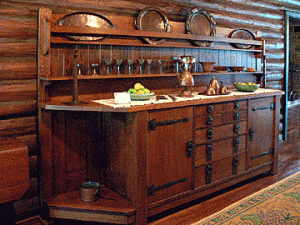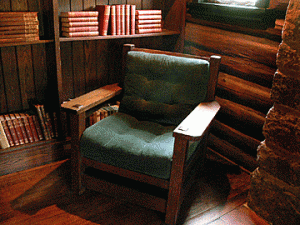Gustav Stickley’s most famous work is Craftsman Farms. This estate not only represented the embodiment of Stickley’s signature American Craftsman style, but was also intended as a platform from which to begin his dream of a utopian community.
In 1908, Stickley’s design company and his magazine were flourishing as the American Arts & Crafts movement was in full swing. He acquired 650 acres of undeveloped land in New Jersey and began designing, then building a community which could be completely self-sufficient. The first building was to be a boys’ school; Stickley would live in a separate house which he designed to be ideal for his use. Unfortunately, his idea generated little interest, and in 1911 he modified the school building to accommodate his family. A few other farm buildings were constructed and the Stickleys lived at Craftsman Farms until Gustav sold the place when he filed for bankruptcy in 1917 as his American Craftsman style lost popularity. The farm was purchased by another family, who eventually sold all but 27 acres of the property. Eventually the remaining land, including the home building, was purchased by the Township of Parsippany-Troy Hills, which was able to preserve it by converting it to a museum and registering it as a National Historic Site.
The original home building is a splendid example of the American Craftsman Style. On the exterior, it is a log cabin with magnificent stone chimneys and white-shuttered windows. In keeping with this style, the roof is extensive and comes low to the ground despite the building having two stories. A key aspect of Stickley’s utopian idea was relying only on local resources to achieve true self-sufficiency. To achieve this, all the materials used in the house – the logs and the stones – were gathered from the 650-acre property.
The home’s interior is filled with more of Stickley’s work. Every bit of furnishing, from beds to cabinets to tables, is done in his style. Even items like lanterns and rugs and pillowcases, though not technically furniture, were done in the same style – Stickley owned four factories and had dozens of options at his disposal.
While Stickley’s dream never became a reality, his work did have a profound impact on American architecture. His legacy lives on through the buildings and furniture he designed, and his innovative ideas about self-sufficiency are invaluable as the need for conservation continues to grow.



